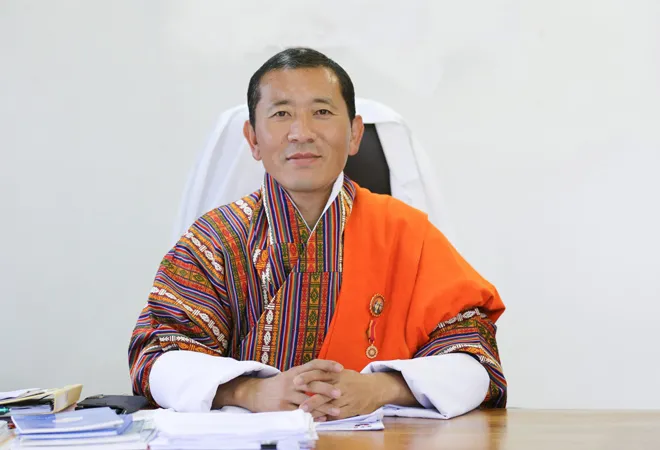
Bhutanese Prime Minister Dasho (Dr) Lotay Tshering’s recent interview with a Belgian paper,
La Libre, regarding the Bhutan-China boundary talks courted controversy in India and beyond. To clear the air, the Bhutanese PM later stated in a Bhutanese newspaper that there was “
no change in position by Bhutan”. This was soon followed by a three-day state visit to India by Bhutan’s King Jigme Khesar Namgyel Wangchuck, from 3-5 April 2023.
Meanwhile, in China, the development brought cheers to the Chinese strategic community, as it was largely interpreted as “
Bhutan publicly speaking out in China’s favour” and “
slapping India in the face”. Some Chinese observers appreciated the fact that the Bhutanese PM’s statement was “
seamlessly synchronised” with China's official stance
on the China-Bhutan border issue, the only difference being the position on Doklam. In the Chinese assessment, the statements that matched perfectly (between China and Bhutan) include “Bhutan does not have major border problems with China”, “territories have not yet been demarcated…draw a line”, that “China has never intruded into Bhutan's territory” etc. Some Chinese observers even
interpreted the Minister’s statement as Bhutan’s rejection of the Indian stance that “the trijunction is located not at Mount Gipmochi but near Batang La some 7-8 km North”, as well as an endorsement of China’s claim that the Pangda Village and related places all belong to China. Overall, the Chinese inference was that “
neighbouring Bhutan has finally taken the initiative to move closer to China,” regardless of its special relationship with India.
Some Chinese observers appreciated the fact that the Bhutanese PM’s statement was “seamlessly synchronised” with China's official stance on the China-Bhutan border issue, the only difference being the position on Doklam.
While analysing China’s expanding footprints in the Himalayan region, one thing becomes clear: China’s robust propaganda machinery and targeted disinformation campaign play a crucial role in its diplomatic success vis-à-vis nations like Nepal and Bhutan. Below is a list comparing China’s English-language propaganda with its Chinese-language domestic discourse on Bhutan.
1. India wants to annex Bhutan” v/s “Bhutan has always been a part of Chinese territory
China’s English-language propaganda machinery, regularly claims that “Bhutan is vulnerable to a
takeover by India”, “that the special relationship between India and Bhutan…stems from… India's regional
hegemony”, that “Bhutan must learn a lesson from Sikkim.” While China, it says, is ready to help Bhutan to get rid of India’s “control”, and promote its sovereignty and independence.
However, if one takes a look at China’s state-controlled internet space, one can see that the dominant Chinese discourse on Bhutan is that the Himalayan nation has always been a part of “
Chinese territory”, shared a suzerain-
vassal relationship with China’s Qing dynasty, and paid tribute to the Tibetan regional government. It also claims that Bhutan is the only country that continues to practice Tibetan Buddhism, is the
only nation in the world that uses the Qing dynasty’s dragon flag, and also
continues to support China’s international position on Tibet, Taiwan, and China’s human rights issue due to its historical status as China’s “vassal” state.
However, in 1772, the British took advantage of the weakening of the Qing dynasty and invaded Bhutan, after which India
inherited the colonial legacy of the British Empire and established an unequal “special relationship" with Bhutan—all these, they say, are historical trends that negatively impacted China at one point in time. But now with China’s growing economic and military might, all “
Chinese territories” occupied by Britain should be returned to China.
2. What is holding back the Bhutan-China border deal—India's obstruction or China’s own geopolitical calculations?
In the interview, the Bhutanese PM expressed hope that the boundary between China and Bhutan could be demarcated within the next one or two meetings. While welcoming the Bhutanese PM’s optimism, most Chinese observers continued to
express doubt if China and Bhutan can actually demarcate the border anytime soon, despite negotiations making great progress. Their stated reason being that, “
India will never allow China and Bhutan to draw a peaceful border line.” India, it is
argued, is reluctant to see China-Bhutan complete a border agreement because that will leave India as the only country with a territorial dispute with China. This will only boost China’s
international image as a peaceful superpower while projecting India as the real aggressor in South Asia.
India, it is argued, is reluctant to see China-Bhutan complete a border agreement because that will leave India as the only country with a territorial dispute with China.
However, after a careful reading of the Chinese language literature on Bhutan, it becomes evident that the real reason why China-Bhutan border negotiations have made limited progress so far is due to China’s reluctance. Chinese observers believe that the China-India and China-Bhutan border disputes are “
inextricably linked” and need to be resolved in a particular
sequence. That is, to solve the border issue thoroughly and completely between China and Bhutan, China and India would need to settle their border issue completely as an essential
pre-condition, and agree to some sort of a “package deal”. In fact,
Qi Pengfei, Professor at Renmin University of China, believes that Bhutan is going to be the
last amongst China’s 14 land neighbours to get its border with China delineated and surveyed. In other words, China wants to keep the pot boiling on the China-Bhutan front and use Bhutan’s territory as a bargaining chip, as and when required, to gain leverage in the China-India border dispute. Just like we saw in 2020, when amidst the Galwan row, China, out of nowhere, staked claim on the Sakteng sanctuary in Eastern Bhutan, which had never figured in border talks between China and Bhutan in the last so many years. Since then, it has been running a
high-pitched campaign for its domestic audience that “the weakest country in the world (Bhutan) is illegally occupying Chinese territory of 3,300 - 3500 square kilometres—Molasading area.”
“China to drive Bhutan’s development” or “Bhutan to drive for TAR’s development”?
Another propaganda narrative often pushed by the Chinese state media is that Bhutan as a country has been
suffering from a backward economy because of the long-term control by India. If China
establishes diplomatic relations with Bhutan, it will contribute to the diversification of Bhutan's industries as well as lead to the rapid development of the country.
However, taking a look at China’s
internal discourse on the issue, it is evident that “China has serious doubts if it can assume India’s position/role in these countries’ development model, since China’s own economic centres and main economic force, being east facing and not west facing, remain far away from these countries”. A case in point could be the Tibet Autonomous Region (TAR). Although China has exercised military control over TAR for all these years, it continues to remain the least developed region in whole of China. Despite repeated high-level interventions by the Chinese leadership, TAR has turned into, what Chinese strategists call, “
an unsustainable, low-efficiency, dependency economy.” Given the development challenges facing the region, the Chinese government has been keen to construct a
South Asia Economic Corridor under its BRI banner, connecting Western China to the bustling markets of northern India.
A case in point could be the Tibet Autonomous Region (TAR). Although China has exercised military control over TAR for all these years, it continues to remain the least developed region in whole of China.
From that perspective, Bhutan, like Nepal, is often seen by the Chinese side as an important platform for TAR’s economic and trade expansion to South Asia
. Although Bhutan is small, Chinese strategists argue that it is comparatively well-connected internationally (compared to TAR) and deeply integrated into the South Asian economic/transit circuit.
What China covets the most is Bhutan’s open borders, and its free trade arrangement with India under which India allows Bhutan to import and export shipments from third-party markets to India without duties
. China hopes that TAR and its adjoining inland Chinese provinces can also use the India-Bhutan open borders and the India-Bhutan Trade, Commerce and Transit Agreement,
to carry out trade with India as well as the whole of South Asia and beyond, thereby, integrating China’s remote western provinces more firmly into the
global economy.
Conclusion
To conclude, looking at the recent developments—developments on the China-Bhutan front as well as China’s renaming exercise in Arunachal Pradesh—it seems like China is poised to use the South Asia card vis-á-vis India, given its limited success so far in convincing India to normalise China-India bilateral ties on Chinese terms, or in preventing the gradual rapprochement of its primary and secondary strategic directions, i.e., the United States and India respectively, thereby reducing the pressure of a “two (or rather multi-front) situation” on itself.
Although Bhutan is small, Chinese strategists argue that it is comparatively well-connected internationally (compared to TAR) and deeply integrated into the South Asian economic/transit circuit.
As a countermeasure, India needs to do more in debunking China’s double-dealings and disinformation campaigns in South Asia that are meant particularly to drive a wedge between India and its neighbours. Secondly, it must better communicate with its Himalayan neighbours that given the history and geography of the region, the security, peace and prosperity of the people of these countries remain closely linked to that of the people of India. Playing the “China v/s India game” is less of a bargaining chip and more of a lose-lose proposition for these nations. Because as explained in the text above, no “gift of development” from China is going to come their way through the TAR, only debt traps and exaggerated territorial claims. On the other hand, Bhutan’s close interaction with China only complicates its ties with India, causes serious mistrust, thereby limiting its role and stake in India’s fledging economy and harming the interest of its own people.
As elaborated in Collection of Treaties on Border Affairs of the People's Republic of China, China-India, China-Bhutan volume , compiled by the Department of Treaty and Law, Ministry of Foreign Affairs of China in 2004
Xu Liang , “西藏自治区与不丹经济合作的优” (Advantages of Economic Cooperation between Tibet Autonomous Region and Bhutan), China's Collective Economy 2018, (33), 167-168
Ibid.
Xu Liang , “西藏自治区与不丹经济合作的优” (Advantages of Economic Cooperation between Tibet Autonomous Region and Bhutan), China's Collective Economy 2018, (33), 167-168
Ibid.
The views expressed above belong to the author(s). ORF research and analyses now available on Telegram! Click here to access our curated content — blogs, longforms and interviews.



 Bhutanese Prime Minister Dasho (Dr) Lotay Tshering’s recent interview with a Belgian paper, La Libre, regarding the Bhutan-China boundary talks courted controversy in India and beyond. To clear the air, the Bhutanese PM later stated in a Bhutanese newspaper that there was “
Bhutanese Prime Minister Dasho (Dr) Lotay Tshering’s recent interview with a Belgian paper, La Libre, regarding the Bhutan-China boundary talks courted controversy in India and beyond. To clear the air, the Bhutanese PM later stated in a Bhutanese newspaper that there was “ PREV
PREV


